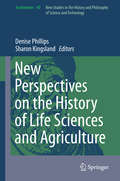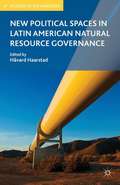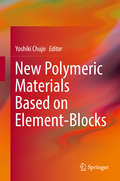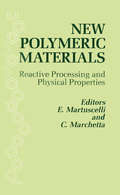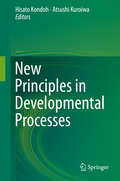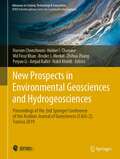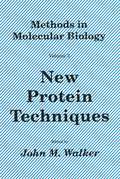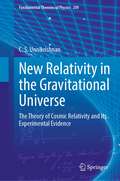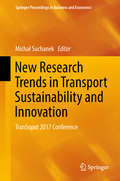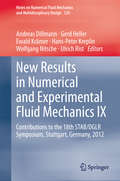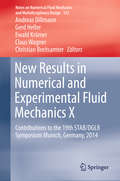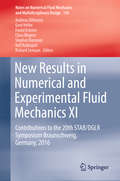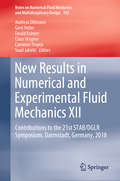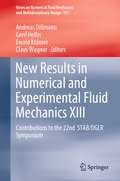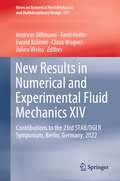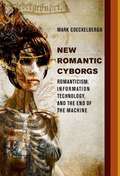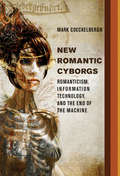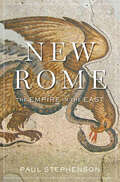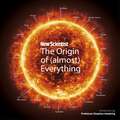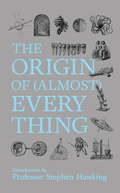- Table View
- List View
New Perspectives on the History of Life Sciences and Agriculture
by Denise Phillips Sharon KingslandThis volume explores problems in the history of science at the intersection of life sciences and agriculture, from the mid-eighteenth to the mid-twentieth century. Taking a comparative national perspective, the book examines agricultural practices in a broad sense, including the practices and disciplines devoted to land management, forestry, soil science, and the improvement and management of crops and livestock. The life sciences considered include genetics, microbiology, ecology, entomology, forestry, and deal with US, European, Russian, Japanese, Indonesian, Chinese contexts. The book shows that the investigation of the border zone of life sciences and agriculture raises many interesting questions about how science develops. In particular it challenges one to re-examine and take seriously the intimate connection between scientific development and the practical goals of managing and improving - perhaps even recreating - the living world to serve human ends. Without close attention to this zone it is not possible to understand the emergence of new disciplines and transformation of old disciplines, to evaluate the role and impact of such major figures of science as Humboldt and Mendel, or to appreciate how much of the history of modern biology has been driven by national ambitions and imperialist expansion in competition with rival nations.
New Philosophical Perspectives on Scientific Progress (Routledge Studies in the Philosophy of Science)
by Yafeng ShanThis collection of original essays offers a comprehensive examination of scientific progress, which has been a central topic in recent debates in philosophy of science. Traditionally, debates over scientific progress have focused on different methodological approaches, notably the epistemic and semantic approaches. The chapters in Part I of the book examine these two traditional approaches, as well as the newly revived functional and newly developed noetic approaches. Part II features in-depth case studies of scientific progress from the history of science. The chapters cover individual sciences including physics, chemistry, evolutionary biology, seismology, psychology, sociology, economics, and medicine. Finally, Part III of the book explores important issues from contemporary philosophy of science. These chapters address the implications of scientific progress for the scientific realism/anti-realism debate, incommensurability, values in science, idealisation, scientific speculation, interdisciplinarity, and scientific perspectivalism. New Philosophical Perspectives on Scientific Progress will be of interest to researchers and advanced students working on the history and philosophy of science.
New Plants
by Lawrence Hall of ScienceIntegrate reading and language arts in the context of science with original student books developed specifically to complement FOSS modules. Students extend and reinforce their classroom discoveries and vocabulary after their hands-on explorations of life, earth, and physical science concepts. Large, colorful photographs and appropriate text enhance the science learning experience.
New Political Spaces in Latin American Natural Resource Governance (Studies of the Americas)
by Håvard HaarstadCase studies written by anthropologists, geographers, political scientists, and sociologists provide empirical detail and analytical insight into states' and communities' relations to natural resource sectors, and show how resource dependencies continue to shape their political spaces.
New Polymeric Materials Based on Element-Blocks
by Yoshiki ChujoThis book introduces the recent progress that has resulted from utilizing the idea of "element-block polymers". A structural unit consisting of various groups of elements is called an "element-block." The design and synthesis of new element-blocks, polymerization of these blocks, and development of methods of forming higher-order structures and achieving hierarchical interface control in order to yield the desired functions are expected to result in manifold advantages. These benefits will encourage the creation of new polymeric materials that share, at a high level, electronic, optical, and magnetic properties not achievable with conventional organic polymeric materials as well as forming properties of molding processability and flexible designability that inorganic materials lack. By pioneering innovative synthetic processes that exploit the reactivity of elements and the preparation techniques employed for inorganic element-blocks, the aim is (1) to create a new series of innovative polymers based on the novel concept of element-block polymers, in which the characteristics of elements are extensively combined and utilized, and (2) to formulate theories related to these polymers. This book demonstrates especially the design strategies and the resulting successful examples offering highly functional materials that utilize element-block polymers as a key unit.
New Polymeric Materials: Reactive Processing and Physical Properties
by E. Martuscelli; C. MarchettaThe development of new polymeric materials has caused a considerable expansion in the field of reactive processing. These new materials are very competitive compared to the traditional ones with respect to production costs and performance. The reports published in this volume present the recent developments and emerging trends in the field of reactive processing and the physical properties of the resulting polymeric materials. Special attention is given to the chemical, kinetic and rheological aspects of reactive processing.
New Principles in Developmental Processes
by Hisato Kondoh Atsushi KuroiwaDuring the last decade, modern technologies have made a revolutionary change in developmental biology. The molecular and cellular processes in live embryos can now be visualized thanks to technologies using fluorescent proteins. The whole genome information of a wide range of animal species has now become available, confirming the common principles that operate in every species. These and other advances in our understanding of the developmental processes during embryogenesis and tissue regeneration have put forward new principles. Those new principles will also be important in the stem cell biology, branched from developmental biology, in order to generate a particular tissue by manipulating stem cells. This book is planned to introduce these new principles to readers who are working in developmental biology and/or stem cell biology fields, with an emphasis on genetic and cellular processes.
New Prospects in Environmental Geosciences and Hydrogeosciences: Proceedings of the 2nd Springer Conference of the Arabian Journal of Geosciences (CAJG-2), Tunisia 2019 (Advances in Science, Technology & Innovation)
by Zhihua Zhang Amjad Kallel Nabil Khélifi Haroun Chenchouni Helder I. Chaminé Broder J. Merkel Md Firoz Khan Peiyue LiThis edited book gives a general overview on current research, focusing on geoenvironmental issues and challenges in hydrogeosciences in model regions in Asia, Europe, and America, with a focus on the Middle East and Mediterranean region and surrounding areas. This proceedings book is based on the accepted papers for oral/poster presentations at the 2nd Springer Conference of the Arabian Journal of Geosciences (CAJG-2), Tunisia 2019. It offers a broad range of recent studies that discuss the latest advances in geoenvironmental and hydrogeosciences from diverse backgrounds including climate change, geoecology, biogeochemistry, water resources management, and environmental monitoring and assessment. It shares insights on how the understanding of ecological, climatological, oceanic and hydrological processes is the key for improving practices in environment management, including the eco-responsibility, scientific integrity, and social and ethical dimensions. It is of interest to scientists, engineers, practitioners, and policymakers in the field of environmental sciences including climatology, oceanography, ecology, biogeochemistry, environmental management, hydrology, hydrogeology, and geosciences in general. In particular, this book is of great value to students and environment-related professionals for further investigations on the state of Earth systems.
New Relativity in the Gravitational Universe: The Theory of Cosmic Relativity and Its Experimental Evidence (Fundamental Theories of Physics #209)
by C. S. UnnikrishnanOur vast Universe is filled with an enormous amount of matter and energy, which are the source of large gravitational potentials affecting all physical phenomena. Because this fact about the size and contents of the Universe was not known when our fundamental theories of dynamics and relativity were completed by the 1920s, the current theories - based as they are in empty space - fail to incorporate cosmic gravity. Though the current theories are consistent with the majority of empirical facts, there are some crucial discrepancies, which demand a drastic shift to a cosmic gravitational paradigm for the theories of relativity and dynamics. The book is a detailed and widely accessible account of this paradigm, called Cosmic Relativity, supported by ample empirical evidence. It is established that all motional relativistic effects are cosmic gravitational effects. The new theory of Cosmic Relativity solves and answers all outstanding questions and puzzles about dynamics and relativity.
New Research Trends in Transport Sustainability and Innovation: Transopot 2017 Conference (Springer Proceedings In Business And Economics)
by Michał SuchanekThis proceedings volume examines the effects of transport on socio-economic development including innovation, public health and cultural behavior. Featuring contributions presented at the 2017 TranSopot Conference in Sopot, Poland, the enclosed papers are divided to provide emerging research in transport sustainability, innovation, structure, and in municipal transport economics. Collectively, the contributions provide not only the theoretical background for transport analysis but also empirical data and practical applications. Researchers in the transport sector strive to explore the nuances of various aspects of transport economics, which are connected on many levels. The sustainability of transport fits into a wide perspective of the sustainable economy. It treats the activities of individuals, companies and local, regional and national governments as means of achieving economic and social ends. Conversely, transport sustainability has a certain burden on society as it may generate external costs in the form of congestion, pollution and negative health effects. Many of these adverse effects might be counteracted by transport innovations, both the technical ones and the organizational ones. These innovations, while their main goal might be to increase the efficiency of the transport entities, should also fit into the desirable trend of responsible economic design thinking. These general ideas of transport research naturally have to influence the research in various branches of transport ranging from the road transport to railway. Lastly, there is the municipal transport, in which goals of different stakeholders are often contradictory which leads to highly complicated decision problems. Featuring case examples on topics as bike sharing, green travel, compact cars, freight transport and electric cars, this book will be of interest to researchers, practitioners, policy makers and students in the fields of transport economics, innovation, and sustainability.
New Results in Numerical and Experimental Fluid Mechanics IX
by Andreas Dillmann Gerd Heller Ewald Krämer Hans-Peter Kreplin Wolfgang Nitsche Ulrich RistThis book presents contributions to the 18th biannual symposium of the German Aerospace Aerodynamics Association (STAB). The individual chapters reflect ongoing research conducted by the STAB members in the field of numerical and experimental fluid mechanics and aerodynamics, mainly for (but not limited to) aerospace applications, and cover both nationally and EC-funded projects. By addressing a number of essential research subjects, together with their related physical and mathematics fundamentals, the book provides readers with a comprehensive overview of the current research work in the field, as well as its main challenges and new directions. Current work on e. g. high aspect-ratio and low aspect-ratio wings, bluff bodies, laminar flow control and transition, active flow control, hypersonic flows, aeroelasticity, aeroacoustics and biofluid mechanics is exhaustively discussed here.
New Results in Numerical and Experimental Fluid Mechanics X
by Andreas Dillmann Gerd Heller Ewald Krämer Claus Wagner Christian BreitsamterThis book presents contributions tothe 19th biannual symposium of the German Aerospace Aerodynamics Association(STAB) and the German Society for Aeronautics and Astronautics (DGLR). Theindividual chapters reflect ongoing research conducted by the STAB members inthe field of numerical and experimental fluid mechanics and aerodynamics,mainly for (but not limited to) aerospace applications, and cover bothnationally and EC-funded projects. Special emphasis is given to collaborativeresearch projects conducted by German scientists and engineers fromuniversities, research-establishments and industries. By addressing a number ofcutting-edge applications, together with the relevant physical and mathematicsfundamentals, the book provides readers with a comprehensive overview of thecurrent research work in the field. Though the book's primary emphasis is onthe aerospace context, it also addresses further important applications, e. g. in ground transportation and energy.
New Results in Numerical and Experimental Fluid Mechanics XI
by Andreas Dillmann Gerd Heller Ewald Krämer Claus Wagner Stephan Bansmer Rolf Radespiel Richard SemaanThis book gathers contributions to the 20th biannual symposium of the German Aerospace Aerodynamics Association (STAB) and the German Society for Aeronautics and Astronautics (DGLR). The individual chapters reflect ongoing research conducted by the STAB members in the field of numerical and experimental fluid mechanics and aerodynamics, mainly for (but not limited to) aerospace applications, and cover both nationally and EC-funded projects. Special emphasis is given to collaborative research projects conducted by German scientists and engineers from universities, research-establishments and industries. By addressing a number of cutting-edge applications, together with the relevant physical and mathematics fundamentals, the book provides readers with a comprehensive overview of the current research work in the field. Though the book's primary emphasis is on the aerospace context, it also addresses further important applications, e. g. in ground transportation and energy.
New Results in Numerical and Experimental Fluid Mechanics XII: Contributions to the 21st STAB/DGLR Symposium, Darmstadt, Germany, 2018 (Notes on Numerical Fluid Mechanics and Multidisciplinary Design #142)
by Cameron Tropea Andreas Dillmann Gerd Heller Ewald Krämer Claus Wagner Suad JakirlićThis book gathers contributions to the 21st biannual symposium of the German Aerospace Aerodynamics Association (STAB) and the German Society for Aeronautics and Astronautics (DGLR). The individual chapters reflect ongoing research conducted by the STAB members in the field of numerical and experimental fluid mechanics and aerodynamics, mainly for (but not limited to) aerospace applications, and cover both nationally and EC-funded projects. Special emphasis is given to collaborative research projects conducted by German scientists and engineers from universities, research-establishments and industries. By addressing a number of cutting-edge applications, together with the relevant physical and mathematics fundamentals, the book provides readers with a comprehensive overview of the current research work in the field. The book’s primary emphasis is on aerodynamic research in aeronautics and astronautics, and in ground transportation and energy as well.
New Results in Numerical and Experimental Fluid Mechanics XIII: Contributions to the 22nd STAB/DGLR Symposium (Notes on Numerical Fluid Mechanics and Multidisciplinary Design #151)
by Andreas Dillmann Gerd Heller Ewald Krämer Claus WagnerThis book offers timely insights into research on numerical and experimental fluid mechanics and aerodynamics, mainly for (but not limited to) aerospace applications. It reports on findings by members of the STAB (German Aerospace Aerodynamics Association) and DGLR (German Society for Aeronautics and Astronautics) and covers both nationally and EC-funded projects. Continuing on the tradition of the previous volumes, the book highlights innovative solutions, promoting translation from fundamental research to industrial applications. It addresses academics and professionals in the field of aeronautics, astronautics, ground transportation, and energy alike.
New Results in Numerical and Experimental Fluid Mechanics XIV: Contributions to the 23rd STAB/DGLR Symposium, Berlin, Germany, 2022 (Notes on Numerical Fluid Mechanics and Multidisciplinary Design #154)
by Andreas Dillmann Gerd Heller Ewald Krämer Claus Wagner Julien WeissThis book offers timely insights into research on numerical and experimental fluid mechanics and aerodynamics, mainly for (but not limited to) aerospace applications. It reports on findings by members of the Deutsche Strömungsmechanische Arbeitsgemeinschaft, STAB (German Aerodynamics/Fluid Mechanics Association) and the Deutsche Gesellschaft für Luft- und Raumfahrt - Lilienthal Oberth e.V., DGLR (German Society for Aeronautics and Astronautics) and covers both nationally and EC-funded projects. Continuing on the tradition of the previous volumes, the book highlights innovative solutions, promoting translation from fundamental research to industrial applications. It addresses academics and professionals in the field of aeronautics, astronautics, ground transportation, and energy alike.
New Romantic Cyborgs: Romanticism, Information Technology, and the End of the Machine
by Mark CoeckelberghRomanticism and technology are widely assumed to be opposed to each other. Romanticism -- understood as a reaction against rationalism and objectivity -- is perhaps the last thing users and developers of information and communication technology (ICT) think about when they engage with computer programs and electronic devices. And yet, as Mark Coeckelbergh argues in this book, this way of thinking about technology is itself shaped by romanticism and obscures a better and deeper understanding of our relationship to technology. Coeckelbergh describes the complex relationship between technology and romanticism that links nineteenth-century monsters, automata, and mesmerism with twenty-first-century technology's magic devices and romantic cyborgs.Coeckelbergh argues that current uses of ICT can be interpreted as attempting a marriage of Enlightenment rationalism and romanticism. He describes the "romantic dialectic," when this new kind of material romanticism, particularly in the form of the cyborg as romantic figure, seems to turn into its opposite. He shows that both material romanticism and the objections to it are still part of modern thinking, and part of the romantic dialectic. Reflecting on what he calls "the end of the machine," Coeckelbergh argues that to achieve a more profound critique of contemporary technologies and culture, we need to explore not only different ways of thinking but also different technologies -- and that to accomplish the former we require the latter.
New Romantic Cyborgs: Romanticism, Information Technology, and the End of the Machine (The\mit Press Ser.)
by Mark CoeckelberghAn account of the complex relationship between technology and romanticism that links nineteenth-century monsters, automata, and mesmerism with twenty-first-century technology's magic devices and romantic cyborgs.Romanticism and technology are widely assumed to be opposed to each other. Romanticism—understood as a reaction against rationalism and objectivity—is perhaps the last thing users and developers of information and communication technology (ICT) think about when they engage with computer programs and electronic devices. And yet, as Mark Coeckelbergh argues in this book, this way of thinking about technology is itself shaped by romanticism and obscures a better and deeper understanding of our relationship to technology. Coeckelbergh describes the complex relationship between technology and romanticism that links nineteenth-century monsters, automata, and mesmerism with twenty-first-century technology's magic devices and romantic cyborgs.Coeckelbergh argues that current uses of ICT can be interpreted as attempting a marriage of Enlightenment rationalism and romanticism. He describes the “romantic dialectic,” when this new kind of material romanticism, particularly in the form of the cyborg as romantic figure, seems to turn into its opposite. He shows that both material romanticism and the objections to it are still part of modern thinking, and part of the romantic dialectic. Reflecting on what he calls “the end of the machine,” Coeckelbergh argues that to achieve a more profound critique of contemporary technologies and culture, we need to explore not only different ways of thinking but also different technologies—and that to accomplish the former we require the latter.
New Rome: The Empire in the East (History Of The Ancient World Ser. #6)
by Paul StephensonA comprehensive new history of the Eastern Roman Empire based on the science of the human past. As modern empires rise and fall, ancient Rome becomes ever more significant. We yearn for Rome’s power but fear Rome’s ruin—will we turn out like the Romans, we wonder, or can we escape their fate? That question has obsessed centuries of historians and leaders, who have explored diverse political, religious, and economic forces to explain Roman decline. Yet the decisive factor remains elusive. In New Rome, Paul Stephenson looks beyond traditional texts and well-known artifacts to offer a novel, scientifically minded interpretation of antiquity’s end. It turns out that the descent of Rome is inscribed not only in parchments but also in ice cores and DNA. From these and other sources, we learn that pollution and pandemics influenced the fate of Constantinople and the Eastern Roman Empire. During its final five centuries, the empire in the east survived devastation by natural disasters, the degradation of the human environment, and pathogens previously unknown to the empire’s densely populated, unsanitary cities. Despite the Plague of Justinian, regular “barbarian” invasions, a war with Persia, and the rise of Islam, the empire endured as a political entity. However, Greco-Roman civilization, a world of interconnected cities that had shared a common material culture for a millennium, did not. Politics, war, and religious strife drove the transformation of Eastern Rome, but they do not tell the whole story. Braiding the political history of the empire together with its urban, material, environmental, and epidemiological history, New Rome offers the most comprehensive explanation to date of the Eastern Empire’s transformation into Byzantium.
New Science, New World
by Denise AlbaneseIn New Science, New World Denise Albanese examines the discursive interconnections between two practices that emerged in the seventeenth century--modern science and colonialism. Drawing on the discourse analysis of Foucault, the ideology-critique of Marxist cultural studies, and de Certeau's assertion that the modern world produces itself through alterity, she argues that the beginnings of colonialism are intertwined in complex fashion with the ways in which the literary became the exotic "other" and undervalued opposite of the scientific.Albanese reads the inaugurators of the scientific revolution against the canonical authors of early modern literature, discussing Galileo's Dialogue on the Two Chief World Systems and Bacon's New Atlantis as well as Milton's Paradise Lost and Shakespeare's The Tempest. She examines how the newness or "novelty" of investigating nature is expressed through representations of the New World, including the native, the feminine, the body, and the heavens. "New" is therefore shown to be a double sign, referring both to the excitement associated with a knowledge oriented away from past practices, and to the oppression and domination typical of the colonialist enterprise. Exploring the connections between the New World and the New Science, and the simultaneously emerging patterns of thought and forms of writing characteristic of modernity, Albanese insists that science is at its inception a form of power-knowledge, and that the modern and postmodern division of "Two Cultures," the literary and the scientific, has its antecedents in the early modern world.New Science, New World makes an important contribution to feminist, new historicist, and cultural materialist debates about the extent to which the culture of seventeenth-century England is proto-modern. It will offer scholars and students from a wide range of fields a new critical model for historical practice.
New Scientist (almost) Everything: The Origin Of (almost) Everything
by Stephen Hawking New Scientist Graham Lawton Jennifer DanielFrom what actually happened in the Big Bang to the accidental discovery of post-it notes, the history of science is packed with surprising discoveries. Did you know, for instance, that if you were to get too close to a black hole it would suck you up like a noodle (it's called spaghettification), why your keyboard is laid out in QWERTY (it's not to make it easier to type) or why animals never evolved wheels? New Scientist does.And now they and award-winning illustrator Jennifer Daniel want to take you on a colorful, whistle-stop journey from the start of our universe (through the history of stars, galaxies, meteorites, the Moon and dark energy) to our planet (through oceans and weather and oil) and life (through dinosaurs to emotions and sex) to civilization (from cities to alcohol and cooking), knowledge (from alphabets to alchemy) ending up with technology (computers to rocket science). Witty essays explore the concepts alongside enlightening infographics that zoom from how many people have ever lived, to showing you how a left-wing brain differs from a right-wing one...
New Scientist (almost) Everything: from the Big Bang to Belly-button Fluff
by Stephen Hawking Graham Lawton New ScientistDOES ANYTHING EAT WASPS meets INFORMATION IS BEAUTIFUL: A journey through life, the universe and everything. From what actually happened in the Big Bang to the accidental discovery of post-it notes, science is packed with surprising discoveries. Did you know, for instance, that if you were to get too close to a black hole it would suck you up like a noodle (it's called spaghettification), why your keyboard is laid out in QWERTY (it's not to make it easier to type) or whether the invention of the wheel was less important to civilisation than the bag (think about it). New Scientist does. And now they and illustrator Jennifer Daniel want to take you on a whistlestop journey from the start of our universe (through the history of stars, galaxies, meteorites, the Moon and dark energy) to our planet (through oceans and weather to oil) and life (through dinosaurs to emotions and sex) to civilisation (from cities to alcohol and cooking), knowledge (from alphabets to alchemy) ending up with technology (computers to rocket science). Witty essays explore the concepts alongside enlightening infographics that zoom from how many people have ever lived to showing you how a left-wing brain differs from a right-wing one.(P)2017 John Murray Press
New Scientist: The Origin of (almost) Everything
by Stephen Hawking Graham Lawton New ScientistIntroduction by Professor Stephen Hawking.When Edwin Hubble looked into his telescope in the 1920s, he was shocked to find that nearly all of the galaxies he could see through it were flying away from one another. If these galaxies had always been travelling, he reasoned, then they must, at some point, have been on top of one another. This discovery transformed the debate about one of the most fundamental questions of human existence - how did the universe begin?Every society has stories about the origin of the cosmos and its inhabitants, but now, with the power to peer into the early universe and deploy the knowledge gleaned from archaeology, geology, evolutionary biology and cosmology, we are closer than ever to understanding where it all came from. In The Origin of (almost) Everything, New Scientist explores the modern origin stories of everything from the Big Bang, meteorites and dark energy, to dinosaurs, civilisation, timekeeping, belly-button fluff and beyond.From how complex life evolved on Earth, to the first written language, to how humans conquered space, The Origin of (almost) Everything offers a unique history of the past, present and future of our universe.
New Smart Materials via Metal Mediated Macromolecular Engineering
by Ezat Khosravi Yuri Savelyev Yusuf YagciControl over macromolecular architecture and resulting material properties has been a central goal of polymer chemistry. There has been much interest in developing new synthetic routes to prepare smart materials with novel compositions and topologies for various applications. The considerable progress in the metal mediated macromolecular engineering over the past decade has had a major impact on the development of well-defined macromolecular architectures and the synthesis of smart materials. Particularly, remarkable strong developments have been observed for the synthesis of smart materials via four metal mediated macromolecular engineering techniques; Anionic, ROMP, ATRP and Click Chemistry. These materials have found uses in advanced microelectronics, technical and biomedical applications as well as in chemical sensors applications. This book is comprised of 27 chapters written by leading scientists from NATO and Partner Countries who have greatly contributed in the area of Anionic, ROMP, ATRP and Click Chemistry. It highlights the fundamental aspects and recent developments of these four powerful techniques and evaluate their potential in the syntheses of smart materials from complex structures (grafts, brushes, dendrimers, etc.) to nanostructures (self-assembly, nano-size, etc) for a wide range of applications. The book reports on the synthesis of a wide range of well-defined complex polymeric systems such as thermoresponsive smart polymers, star copolymers, biocompatible polymers, amphipilic smart nano structured, conducting polymers, self assembled polymers, and hyperbranced polymers.
